
Viking Areas in Iceland - Eiríksstaðir Long House in West Iceland and Leifur the Lucky
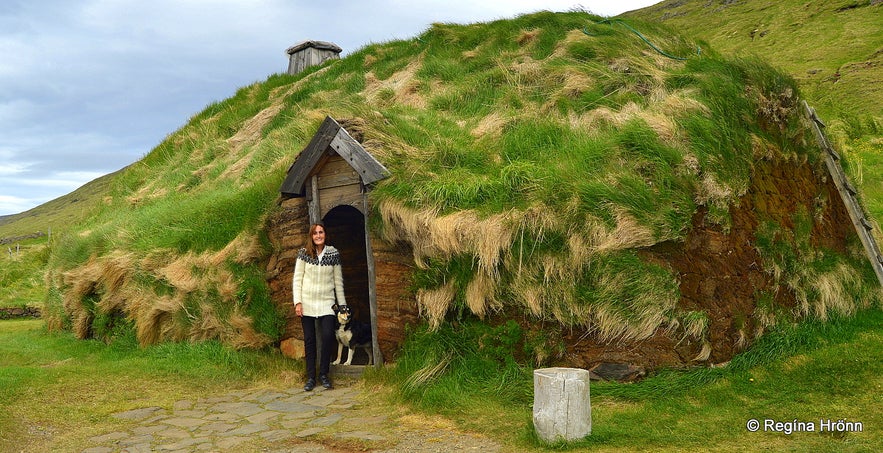
Have you ever wanted to see how the Vikings lived? You will get the opportunity to do so in West Iceland, where you will find a hypothesis Viking longhouse.
It is called Eiríksstaðir and I visit it every time I travel to this area.
I feel like I am stepping back in time when I visit this longhouse.
Top photo: Eiríksstaðir back in 2015
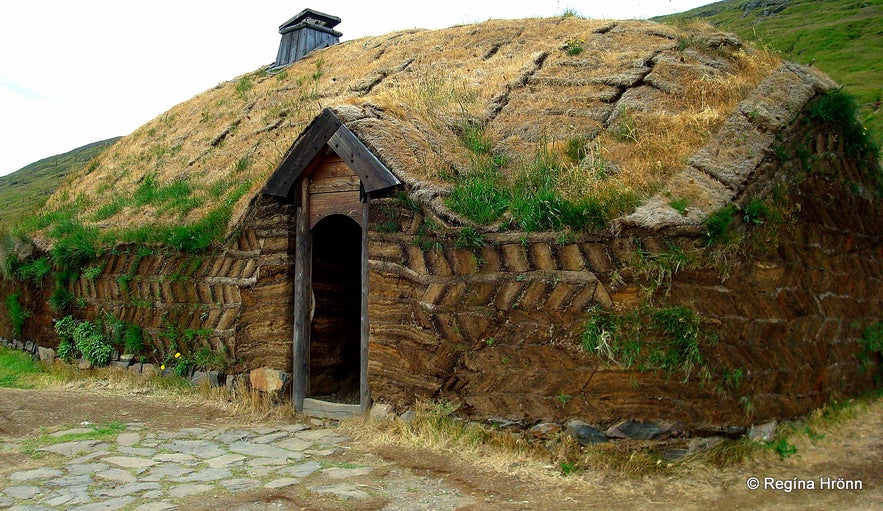
Eiríksstaðir in 2010
The Vikings started coming over to Iceland to settle here in around the year 874, give or take a couple of years.
So naturally, there are many areas in Iceland that are rich in Viking history. And Eiríksstaðir in West Iceland is pure Viking :)
The Viking longhouse at Eiríksstaðir is a hypothesis house of the old Saga age longhouse where Eiríkur rauði - Erik the Red (died approx. 1006 in Greenland) and his wife Þjóðhildur lived.
Our lovely very knowledgeable guide in 2019 at Eiríksstaðir - I do NOT look good in a helmet ;)
Erik the Red and his father, Þorvaldur, had to leave Norway because of killings and first lived at Drangar in Hornstrandir, where his father died.
Eiríkur then married Þjóðhildur and moved to Eiríksstaðir. But he was chased out of Eiríksstaðir for the killings of Eyjólfur saur and Hólmgöngu-Hrafn as you can read about in both Grænlendingasaga (Icelandic) and in The Saga of Erik the Red.

Eiríksstaðir in 2019
He, therefore, went to live at Eiríksstaðir on the Öxney (Yxney) island in the Breiðafjörður islands.
He then fought with Þorgestur at Breiðabólstaður at Skógarströnd and killed two of his sons and other men, and was found guilty at Þórsnessþing district parliament. You can read about Þórsnessþing in Eyrbyggja Saga.
Eiríkur prepared a ship in Eiríksvogur and sailed for Greenland, but he had heard about this land called Gunnbjarnarsker which Gunnbjörn Úlfsson had seen.
He stayed for 3 years in Greenland, until he came for a visit to Breiðarfjörður and stayed in Iceland for one winter. 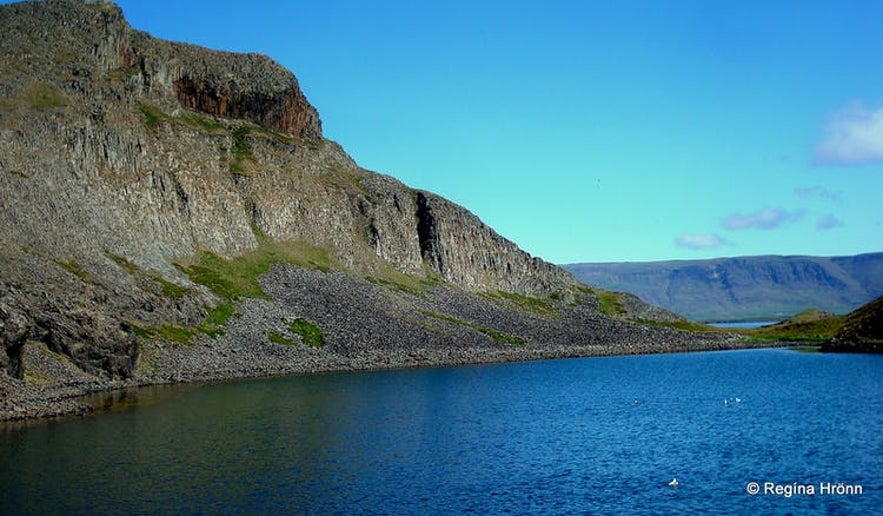
Breiðafjarðar islands in West-Iceland
He then returned to Greenland and lived at Brattahlíð in Eiríkssfjörður fjord and was a highly-respected man.
Eiríkur gave Greenland its name, Greenland, to get people to move there. That name was quite a contradiction, as Greenland is almost covered in ice.
According to Grænlendinga Saga, 25 ships left Iceland for Greenland in the year 985, but only 14 ships managed to reach Greenland.
Eiríksstaðir might be the place where the son of Eiríkur and Þjóðhildur, Leifur heppni - Leif the Lucky (around (970) 980-1020) was born.

The statue of Leifur at Eiríksstaðir
Leifur had heard of a land further west that Bjarni Herjólfsson had seen when he got lost on his way to Greenland. Leifur wanted to see this land and bought a ship from Bjarni.
Leifur left Greenland and sailed to North America. He was the first European to land there; thus it is said that Leifur "discovered" America and not Columbus in 1492 - and not Bjarni as he had only seen this land and not set foot ashore.
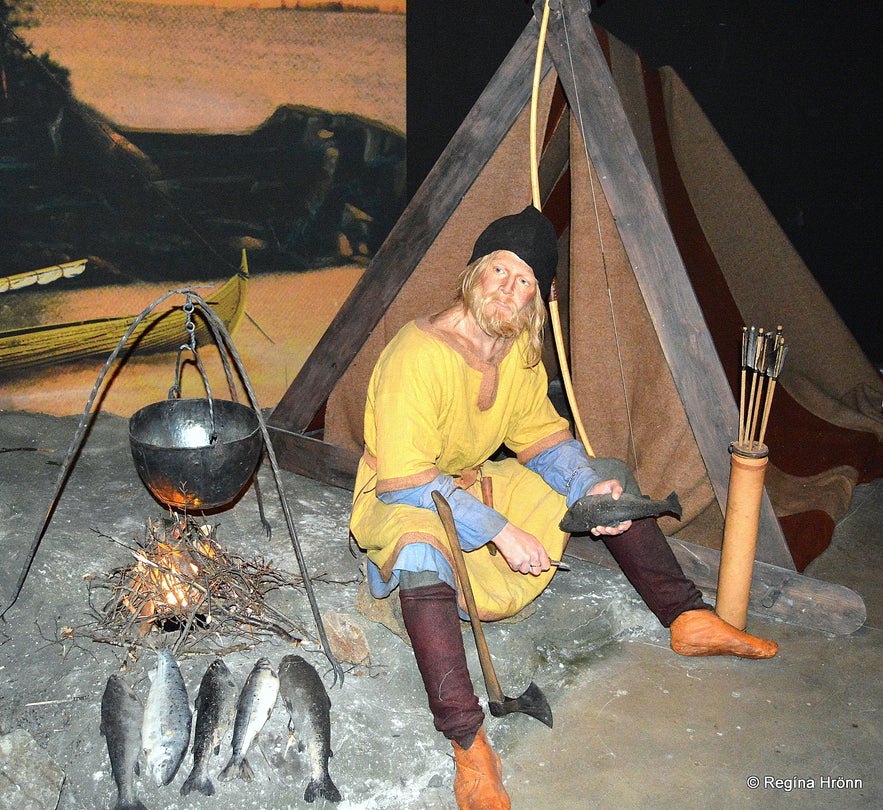
Leif the Lucky as depicted at the Saga Museum in Reykjavík, which I also recommend visiting
Leifur named this land Vínland or Wine country as they found grapes there. They built a longhouse and stayed for one winter and then sailed back to Greenland the next spring with a ship filled with grapes and wood.
On his way back to Greenland Leifur rescued 15 men (and women) from a reef and got the nickname "heppni" or "the lucky".
Amongst them were Þórir Austmaður and Guðríður, Þórir was the first husband of Guðríður Þorbjarnardóttir, who was later to become Leifur's sister-in-law when she married Þorsteinn Eiríksson after the death of Þórir.
See also my travel-blog about Guðríður, the most widely travelled woman of the Middle Ages.

The statue of Leifur heppni - Leif the Lucky at Eiríksstaðir
Leifur became a missionary in Greenland at the command of the Norwegian king Ólafur Tryggvason. His mother built the first church in Greenland, Þjóðhildarkirkja church, which was named after her. But his father, Erik, never converted to Christianity.
Leifur had 3 siblings, Þorsteinn, Þorvaldur, and Freydís, who all wanted to see Vínland and the Sagas tell us about their journey and adventures there.
 Eiríksstaðir in 2023
Eiríksstaðir in 2023
According to Grænlendingasaga, Þorvaldur died in Vínland (got killed by the natives) and Þorsteinn, who wanted to fetch his brother's body in Vínland, got lost on his journey and never reached Vínland.
Þorsteinn and Guðríður Þorbjarnadóttir arrived at Lýsufjörður in Greenland, where they stayed with Þorsteinn svarti. Here Þorsteinn Eiríksson died of a contagious illness, and Þorsteinn svarti's wife also caught this illness and died.
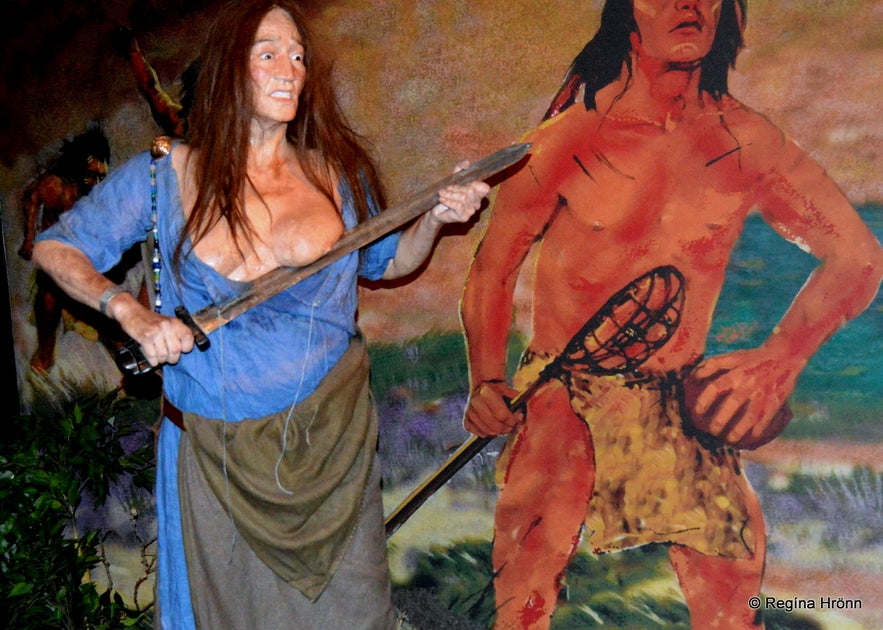
Freydís Eiríksdóttir as depicted at the Saga Museum in Reykjavík - an event from Eiríks Saga
Guðríður later married Þorfinnur karlsefni, sailed with him to Vínland, and had the first European child, Snorri, there.
There are different accounts of their adventures and fate in Eiríks Saga and Grænlendingasaga, so it is best to read both of them (short Sagas) if you want to know more about what happened to Eiríkur, Þjóðhildur, and co. I prefer Grænlendingasaga, but there are also interesting accounts in Eiríks Saga, so they complement each other.
The story of Freydís, their sister, is also very different in these 2 Sagas. In Grænlendingasaga she is depicted as a true villain, but she has a smaller role in Eiríks Saga and one of the accounts shows her pregnant in a strange situation in Vínland, as you can tell from my photo above, which I took from the excellent museum, the Saga Museum in Reykjavík.

The ruins of the old longhouse
At Eiríksstaðir you can walk up to the ruins of the more than 1000-year-old lodge and you will find a statue of Leif the Lucky close to the ruins.
It is believed that these people lived in this longhouse until around 980.
The ruins were covered with grass after the archaeological excavation, so many people don't know about them - but on this spot the longhouse of Erik the Red was most likely located.
The Saga age longhouse was opened in the year 2000 some 100 metres from the ruins of the original longhouse. 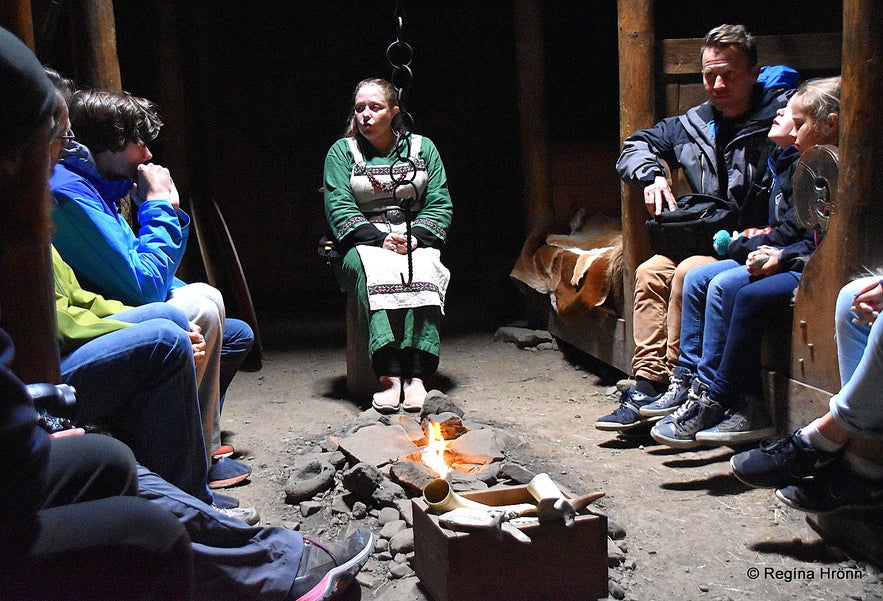
Storytelling by the longfire at Eiríksstaðir
At the same time the replica of a Viking ship Íslendingur - the Icelander set off for America in the trails of Leif the Lucky 1000 years earlier.
The longhouse is built with a remake of old Viking tools and is said to be the best-built longhouse in all of Europe.
It is a very cute longhouse and has a fire burning inside it like in the old Viking homes. The staff is dressed in Viking costumes, a "knock-off" of the Viking fashion from the 10th century. Inside the longhouse, they told us the story of the Vikings, who lived in this area. We were also shown a pair of Viking bone skates.
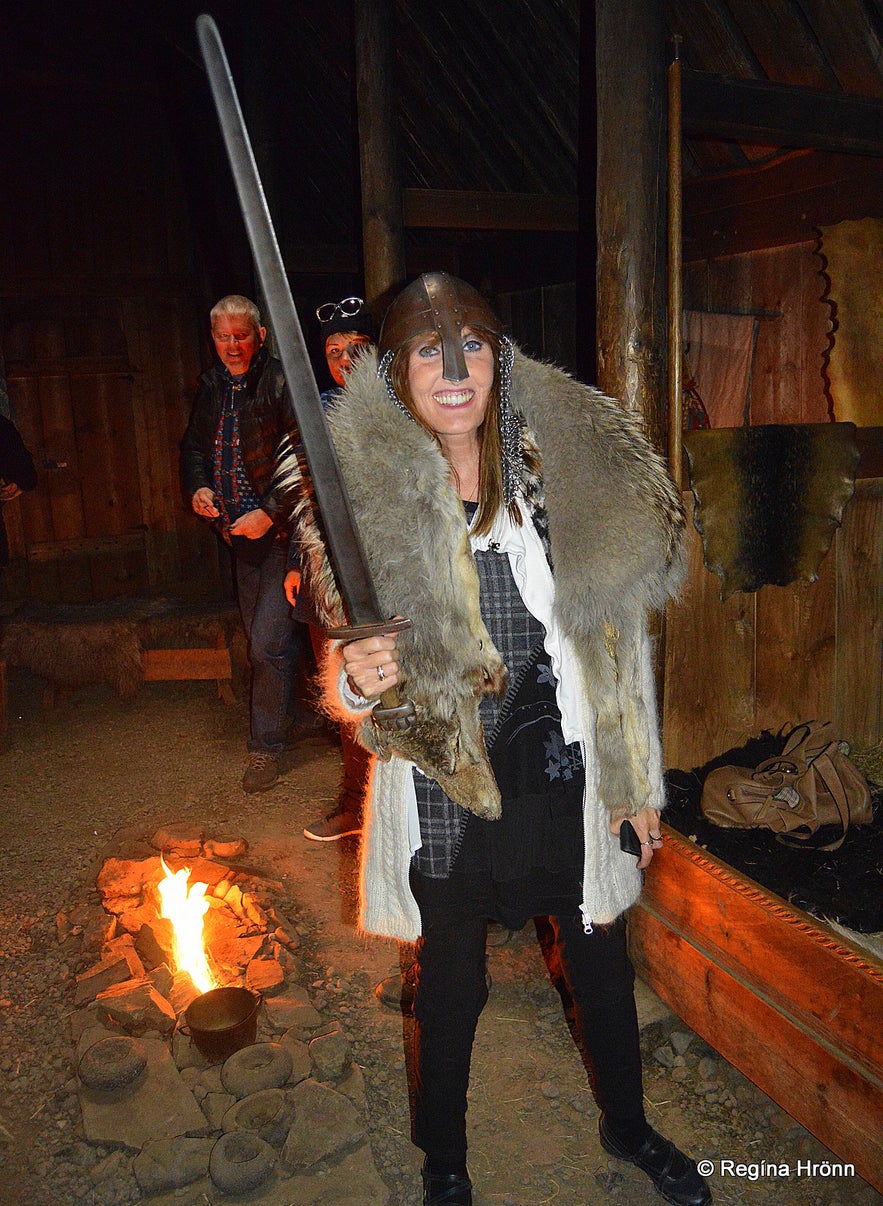
From my visit to Eiríksstaðir in 2015
We got to dress up like Vikings and try the Viking weapons, so you can get some great photos at Eiríksstaðir. Notice that the helmet is without horns; most people believe that Viking helmets had horns on them, but that is not true. No Viking helmets have been found with horns.
The Vikings used horns to drink from and made tools from the horns, but they didn't put them on their helmets. And the ordinary Viking didn't even own a helmet as the metal in the helmets was very expensive.
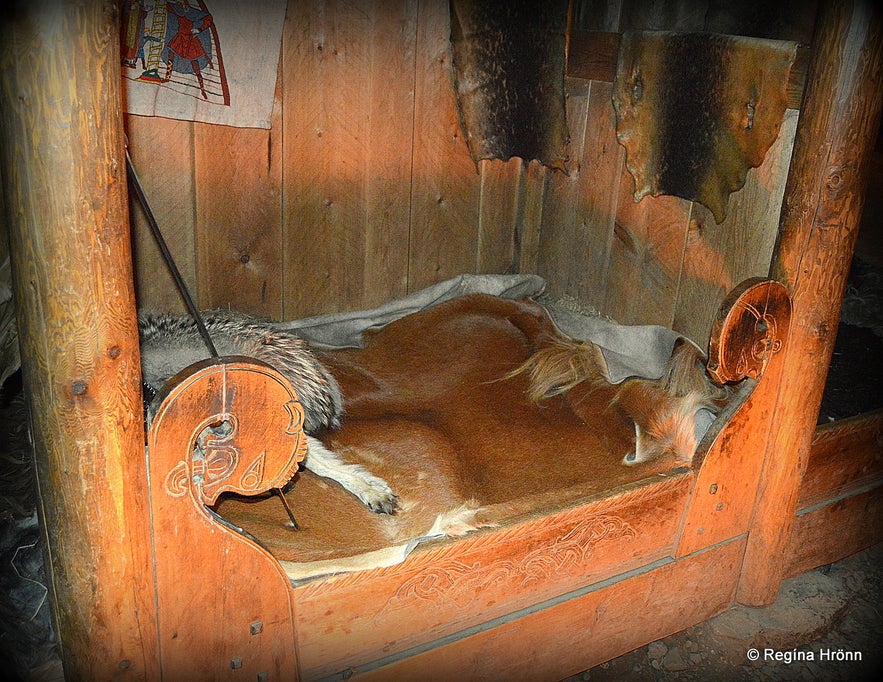
One of the beds at Eiríksstaðir
The storyteller told us the story of Eiríkur rauði, Þjóðhildur, and Leifur and how the Vikings lived and worked in the longhouse. There was a long fire in the middle of the longhouse and the Vikings slept sitting in an upright position so as to not choke from the smoke from the fire, the storyteller told us.
The most ornate bed belonged to the masters of the house and the servants slept in beds that had a lower front than that of the masters of the house. And the virgins slept in the attic (see the photo below) where they were protected from the men.
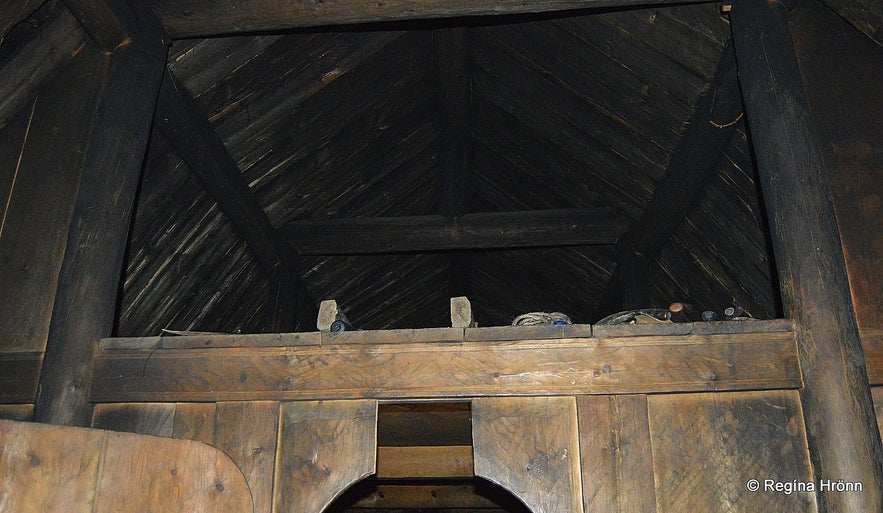
It is believed that around 20 people were living in this house at the same time, so it must have been crowded! And then sometimes groups of winter guests stayed there as well - for the longest time!
The women in Iceland were very powerful as can be read in the Icelandic Sagas.
And the women had the key to the pantry and there the men were not allowed to go - as the Viking men were known to eat everything at sight - much as our men today ;)
At Eiríksstaðir emphasis is put on the role of women, as often their important role is left out and the emphasis is put entirely on the role of the Viking men.
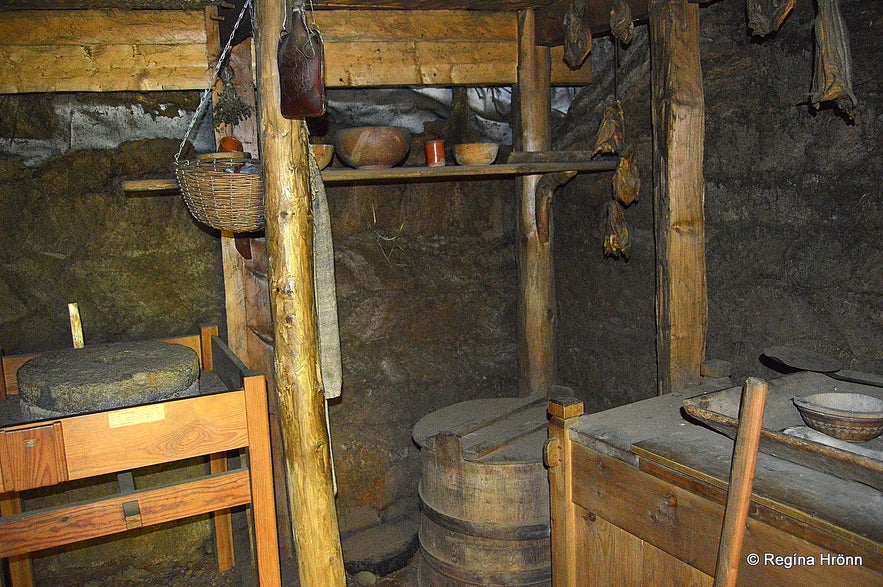
The pantry
In 2019 Eiríksstaðir got new proprietors and a food truck was added, where you can get some traditional Icelandic food.
It is called Þjóðhildarpotturinn or the Kitchen of Erik the Red and here you can buy food from the 21st century as well as Viking-style food from the 10th century. They offer f.ex. traditional meat broth smoked trout and cured lamb.
If you are not into that kind of food then they also offer sandwiches :)
The new proprietors have got many good ideas about how to make the best use of Eiríksstaðir. A Viking festival is planned for the last weekend in August.
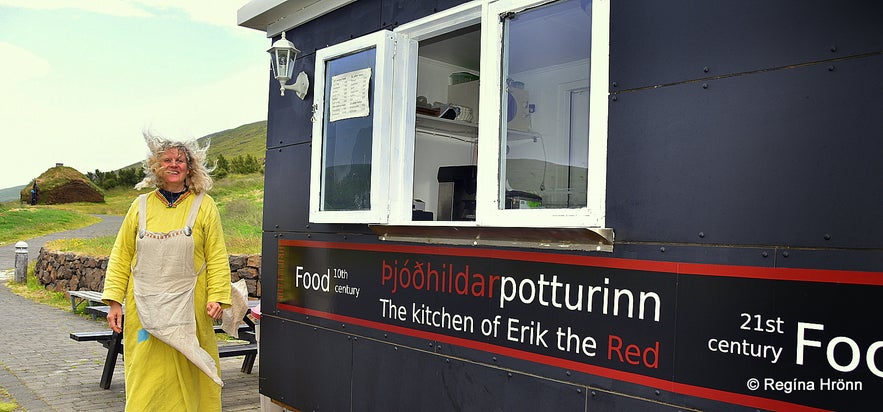
The food truck and the lovely Viking woman serving food - it was very windy during my last visit to Eiríksstaðir
It is so worth visiting this lovely hypothesis Viking longhouse while travelling in West Iceland. I always feel like I have stepped into the Viking ages when visiting Eiríksstaðir longhouse. So don't miss it if you would like to experience the Viking side of Iceland.
I have written other travel-blogs about Vikings activities in Iceland if you want to get acquainted with the Vikings in Iceland, f.ex.:
Unleash your Inner Viking Warrior with a Professional Viking Portrait in Reykjavík
The Icelandic Vikings and Viking Activities in Iceland today
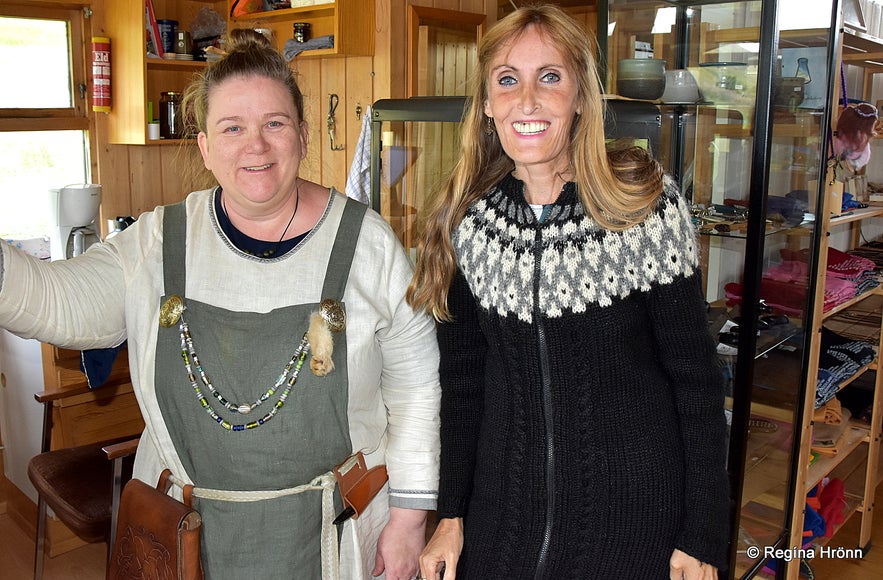
With Bjarnheiður Jóhannsdóttir, one of the new proprietors of Eiríksstaðir
Eiríksstaðir is open daily from May 1st until September 30th, from 09:00-17:00 (9 am-5 pm). There is an entrance fee for adults, but children enter the longhouse for free. Guidance and storytelling by the long fire is offered every half an hour. Tickets are sold at a ticket office by the car park. In the wintertime, pre-booked groups can visit.
For more information check out their website Eiríksstaðir.
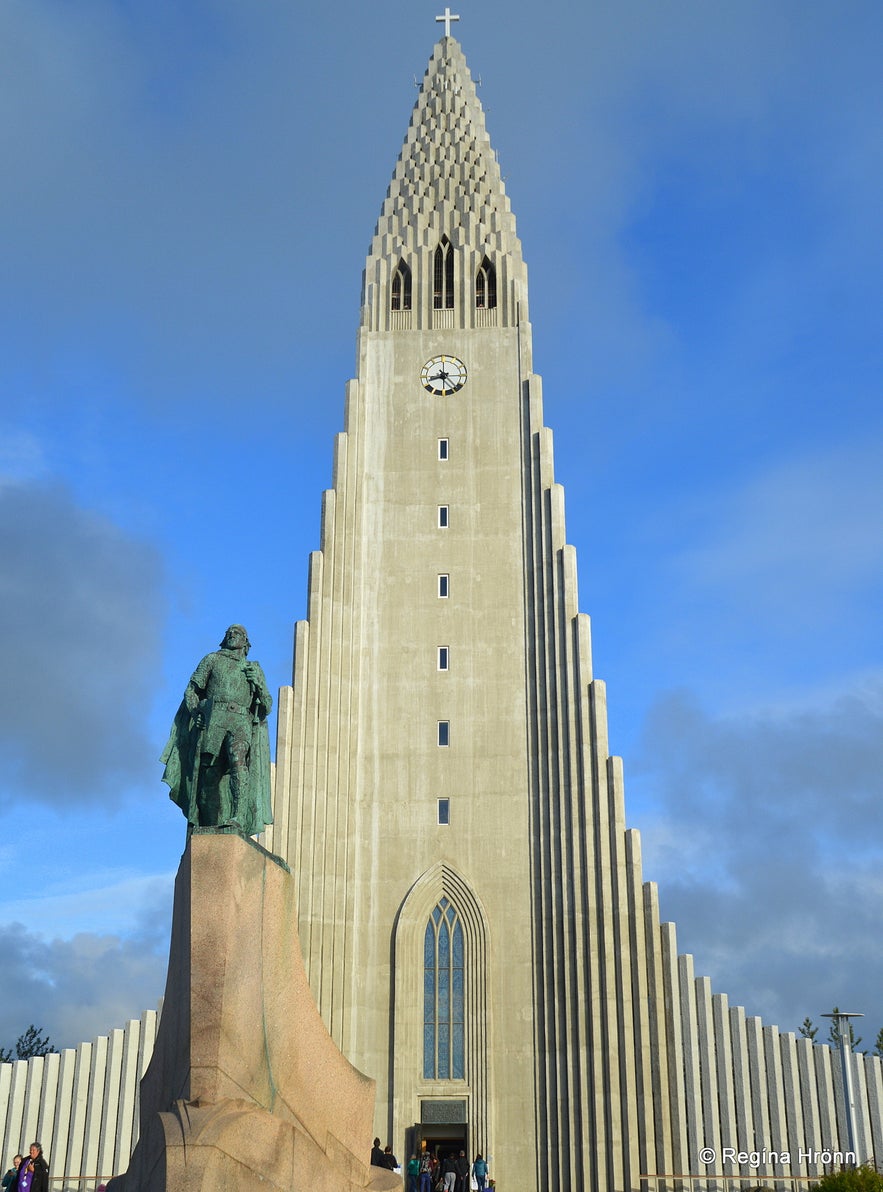 The statue of Leifur Eiríksson in front of Hallgrímskirkja church in Reykjavík
The statue of Leifur Eiríksson in front of Hallgrímskirkja church in Reykjavík
Eiríksstaðir longhouse is located in West Iceland, 76 km north of Borgarnes on the way to the Westfjords. From Borgarnes, drive on ring-road 1 north towards Akureyri, turn left onto road 60 heading towards Hólmavík.
Turn right onto road 586 (before reaching Búðardalur) and drive for 8 km into Haukadalur past a lake until you see Eiríksstaðir on your left-hand side. On the junction of roads 586 and 60, you will see a sign above. "Eiríksstaðir fæðingarstaður Leifs heppna" means Eiríksstaðir the birthplace of Leif the Lucky.
The closest village is Búðardalur, which is 15 km away. Here is the location of Eiríksstaðir on the map. GPS: 65°03'32.9"N 21°32'20.4"W

Evidence for European presence in the Americas in AD 1021
The travel-blog on Eiríksstaðir Viking Longhouse is my second travel-blog here on Guide to Iceland, written back in 2013, but I update it regularly. Since then I have written 300 travel-blogs on various locations and activities in my country.
Have a lovely time exploring the Viking areas of Iceland :)
Sources:
Grænlendingasaga (Icelandic)
기타 흥미로운 블로그
요쿨살론부터 비크까지, 꽃보다 청춘 5화
드디어 하늘씨과 쓰리스톤즈가 합류했는데요! 설원을 달리는 모습에 저도 아이슬란드가 엄청 그리워졌답니다. 빙하와 빛나는 요쿨살론 첫번째로 향한 요쿨살론(Jokulsarlon)은 아이슬란드의 대표적인 명소 중 하나랍니다. 영어로 Glacier lagoon 이라고도 하는데요. 방송에 나온 것처럼 눈 앞에 보이는 빙하는 빙하수가 흘러서 녹았다 얼었다를더 보기스코가포스 폭포부터 오로라까지, 꽃보다청춘 4화를 따라서
여행 5일째, 포스톤즈가 처음으로 향한 곳은 아이슬란드 남부에 있는 스코가포스 폭포(skogasfoss)입니다. 아이슬란드 남부의 대표적인 폭포 중 하나에요. 방송에서는 들르지 않았지만 스코가포스 거의 바로 옆에 위치한 셀리야란드스포스(seljalandsfoss) 폭포와 함께 같이 들르곤 한답니다. 스코가포스 폭포는 폭포의 물줄기 끝까지 올라갈 수 있단더 보기꽃청춘을 따라서
요즘 인기리에 방영되고 있는 꽃보다 청춘 아이슬란드편! 저도 매주 빼놓지 않고 시청하고 있습니다. 많은 분들께서 포스톤즈의 발랄한 매력과 아이슬란드의 놀라운 경치에 빠져드셨을 것 같습니다! 이번에는 꽃보다 청춘을 따라서 아이슬란드를 한번 가보도록 해요! 사실 아이슬란드가 한국에서 그렇게 가기 쉬운 나라는 아닙니다. 거리도 멀고 항공권도 비싸고! 우더 보기

아이슬란드 최대의 여행 마켓플레이스를 전화에 다운로드하여 전체 여행을 한 곳에서 관리하세요
전화 카메라로 이 QR 코드를 스캔하고 표시되는 링크를 누르면 아이슬란드 최대의 여행 마켓플레이스를 주머니에 넣을 수 있답니다. 다운로드 링크가 포함된 SMS 또는 이메일을 받으려면 전화번호 또는 이메일 주소를 추가하세요.
















